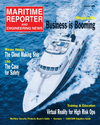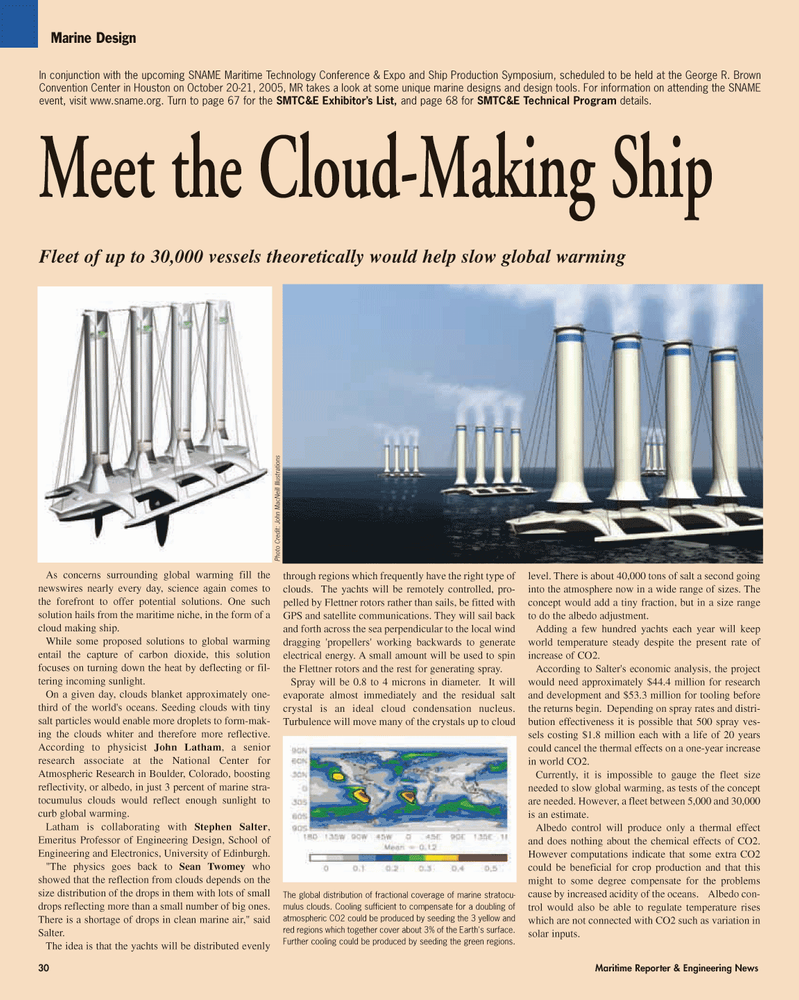
Page 30: of Maritime Reporter Magazine (October 2005)
The Marine Design Annual
Read this page in Pdf, Flash or Html5 edition of October 2005 Maritime Reporter Magazine
30 Maritime Reporter & Engineering News
As concerns surrounding global warming fill the newswires nearly every day, science again comes to the forefront to offer potential solutions. One such solution hails from the maritime niche, in the form of a cloud making ship.
While some proposed solutions to global warming entail the capture of carbon dioxide, this solution focuses on turning down the heat by deflecting or fil- tering incoming sunlight.
On a given day, clouds blanket approximately one- third of the world's oceans. Seeding clouds with tiny salt particles would enable more droplets to form-mak- ing the clouds whiter and therefore more reflective.
According to physicist John Latham, a senior research associate at the National Center for
Atmospheric Research in Boulder, Colorado, boosting reflectivity, or albedo, in just 3 percent of marine stra- tocumulus clouds would reflect enough sunlight to curb global warming.
Latham is collaborating with Stephen Salter,
Emeritus Professor of Engineering Design, School of
Engineering and Electronics, University of Edinburgh. "The physics goes back to Sean Twomey who showed that the reflection from clouds depends on the size distribution of the drops in them with lots of small drops reflecting more than a small number of big ones.
There is a shortage of drops in clean marine air," said
Salter.
The idea is that the yachts will be distributed evenly through regions which frequently have the right type of clouds. The yachts will be remotely controlled, pro- pelled by Flettner rotors rather than sails, be fitted with
GPS and satellite communications. They will sail back and forth across the sea perpendicular to the local wind dragging 'propellers' working backwards to generate electrical energy. A small amount will be used to spin the Flettner rotors and the rest for generating spray.
Spray will be 0.8 to 4 microns in diameter. It will evaporate almost immediately and the residual salt crystal is an ideal cloud condensation nucleus.
Turbulence will move many of the crystals up to cloud level. There is about 40,000 tons of salt a second going into the atmosphere now in a wide range of sizes. The concept would add a tiny fraction, but in a size range to do the albedo adjustment.
Adding a few hundred yachts each year will keep world temperature steady despite the present rate of increase of CO2.
According to Salter's economic analysis, the project would need approximately $44.4 million for research and development and $53.3 million for tooling before the returns begin. Depending on spray rates and distri- bution effectiveness it is possible that 500 spray ves- sels costing $1.8 million each with a life of 20 years could cancel the thermal effects on a one-year increase in world CO2.
Currently, it is impossible to gauge the fleet size needed to slow global warming, as tests of the concept are needed. However, a fleet between 5,000 and 30,000 is an estimate.
Albedo control will produce only a thermal effect and does nothing about the chemical effects of CO2.
However computations indicate that some extra CO2 could be beneficial for crop production and that this might to some degree compensate for the problems cause by increased acidity of the oceans. Albedo con- trol would also be able to regulate temperature rises which are not connected with CO2 such as variation in solar inputs.
In conjunction with the upcoming SNAME Maritime Technology Conference & Expo and Ship Production Symposium, scheduled to be held at the George R. Brown
Convention Center in Houston on October 20-21, 2005, MR takes a look at some unique marine designs and design tools. For information on attending the SNAME event, visit www.sname.org. Turn to page 67 for the SMTC&E Exhibitor’s List, and page 68 for SMTC&E Technical Program details.
Marine Design
Meet the Cloud-Making Ship
Fleet of up to 30,000 vessels theoretically would help slow global warming
The global distribution of fractional coverage of marine stratocu- mulus clouds. Cooling sufficient to compensate for a doubling of atmospheric CO2 could be produced by seeding the 3 yellow and red regions which together cover about 3% of the Earth's surface.
Further cooling could be produced by seeding the green regions.
Photo Cr edit: John MacNeill Illustrations
MR OCTOBER 2005 #4 (25-32).qxd 9/29/2005 8:06 AM Page 30

 29
29

 31
31
